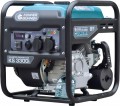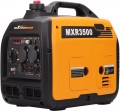Max. power
The maximum power output that the generator can provide.
This power is slightly higher than the nominal (see above), but the maximum performance mode can only be maintained for a very short time - otherwise an overload occurs. Therefore, the practical meaning of this characteristic is mainly to describe the efficiency of the generator when working with increased starting currents.
Let us recall that some types of electrical appliances consume several times more power (and, accordingly, power) at the moment of starting than in the normal mode; this is typical mainly for devices with electric motors, such as power tools, refrigerators, etc. However, increased power for such equipment is needed only for a short time, normal operation is restored in literally a few seconds. And you can estimate the starting characteristics by multiplying the nominal power by the so-called starting coefficient. For equipment of the same type, it is more or less the same (1.2 - 1.3 for most power tools, 2 for a microwave oven, 3.5 for an air conditioner, etc.); more detailed data is available in special sources.
Ideally, the maximum power of the generator should be no less than the total peak power of the connected load - that is, the starting power of equipment with a starting factor greater than 1 plus the rated power of all other equipment. This will minimize the likelihood of overloads.
Alternator winding
—
Copper. Copper winding is typical for advanced class generators. The copper alternator is characterized by high conductivity and low resistance. The conductivity of copper is 1.7 times higher than the conductivity of aluminium, such a winding heats up less, and compounds made of this metal endure temperature drops and vibration loads. Among the disadvantages of the copper winding, one can only note the high cost of the alternator. Otherwise, generators with copper winding have high reliability and durability.
— Aluminium. The aluminium winding of the alternator is typical for low-cost-class generators. The main advantages of aluminium are light weight and low price; otherwise, such a winding is usually inferior to copper counterparts. An oxide film is created on the surface of aluminium, it appears everywhere, even in the places of contact soldering. The oxide film undermines the contacts and does not allow the outer protective braid to securely hold the aluminium conductors.
Motor type
Model name of the engine installed in the generator. Knowing this name, you can, if necessary, find detailed data on the engine and clarify how it meets your requirements. In addition, model data may be needed for some specific tasks, including maintenance and repair.
Note that modern generators are often equipped with
branded engines from famous manufacturers: Honda, John Deere, Mitsubishi, Volvo, etc. Such engines are more expensive than similar units from little-known brands, but this is offset by higher quality and/or solid warranty conditions , and in many cases, the ease of finding spare parts and additional documentation (such as manuals for special maintenance and minor repairs).
Engine size
The working volume of the engine in a gasoline or diesel generator (see "Fuel"). Theoretically, more volume usually means more power, but in fact, everything is not so clear. Firstly, the specific power strongly depends on the type of fuel, and in gasoline units, also on the type of internal combustion engine (see above). Secondly, similar engines of the same power can have different volumes, and there is a practical point here: with the same power, a larger engine consumes more fuel, but by itself it can cost less.
Power
The operating power of the engine installed in the generator. Traditionally stated in horsepower; 1 HP approximately equal to 735 watts.
First of all, the rated power of the generator directly depends on this indicator (see above): in principle, it cannot be higher than the engine power, moreover, part of the engine power is spent on heat, friction and other losses. And the smaller the difference between these capacities, the higher the efficiency of the generator and the more economical it is. However high efficiency affects the cost, but this difference can pay off with regular use due to fuel savings.
Fuel consumption (50% load)
Fuel consumption of a petrol or diesel generator when operating at half power, and for combined models when using petrol (see “Fuel”).
Fuel consumption usually increases with load. However, generator efficiency is not always linear - fuel consumption may vary disproportionately with different loads. In this case, the approximate amount of fuel consumed by the generator when operating at half power (50% of the rated power) is given. Knowing the fuel consumption and tank capacity, you can at least estimate how long one fill-up will last.
Fuel tank volume
The volume of the fuel tank installed in the generator.
Knowing the fuel consumption (see above) and the capacity of the tank, you can calculate the operating time on one gas station (if it is not indicated in the specifications). However, a more capacious tank is also more bulky. Therefore, manufacturers choose tanks based on the general level and "voracity" of the generator — in order to provide an acceptable operating time without a significant increase in size and weight. So in general, this parameter is more of a reference than practically significant.
As for the numbers, in low-power models, tanks are installed for
5 – 10 liters, or even
less ; in heavy professional equipment, this figure can
exceed 50 liters.
Fuel level indicator
A pointer that allows you to monitor the remaining fuel in the generator tank. The simplest such
indicators work only with a critical decrease in the level of fuel, warning of the need for refueling; more advanced ones constantly display the remainder. However, anyway, this feature makes it easier to keep track of the fuel supply and reduces the risk of a generator shutdown due to a forgotten refueling.
USB charging port
The generator has
a USB connector(one or more) for charging various devices. Most modern smartphones and tablets can be charged from USB, and this charging method is also found in many other equipment - from cameras and flashlights to electric screwdrivers and radio-controlled models. The standard supply voltage through this connector is 5 V, but the power may be different, it should be specified separately.

